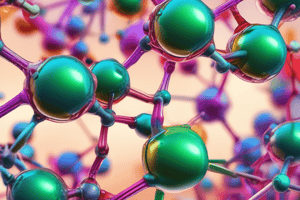Podcast
Questions and Answers
What is the common name for the azetidinone ring found in penicillins and cephalosporins?
What is the common name for the azetidinone ring found in penicillins and cephalosporins?
The β-lactam ring
How do β-lactam antibiotics kill bacteria?
How do β-lactam antibiotics kill bacteria?
By inhibiting cell wall synthesis
Name the antimalarial drug that belongs to the 4-aminoquinoline class and is considered one of the most successful antimalarial agents.
Name the antimalarial drug that belongs to the 4-aminoquinoline class and is considered one of the most successful antimalarial agents.
Chloroquine
What is the IUPAC name for the heterocyclic compound found in chloroquine?
What is the IUPAC name for the heterocyclic compound found in chloroquine?
Name two proton pump inhibitors (PPIs) used as anti-ulcer drugs that contain a pyridine moiety.
Name two proton pump inhibitors (PPIs) used as anti-ulcer drugs that contain a pyridine moiety.
Give an example of a non-aromatic heterocycle discussed in the text.
Give an example of a non-aromatic heterocycle discussed in the text.
Give an example of an aromatic heterocycle discussed in the text.
Give an example of an aromatic heterocycle discussed in the text.
What class of antibiotics do penicillins and cephalosporins belong to?
What class of antibiotics do penicillins and cephalosporins belong to?
What property of nitrogen heterocycles makes them valuable as organic bases?
What property of nitrogen heterocycles makes them valuable as organic bases?
Name a valuable laboratory solvent that is a nitrogen heterocycle.
Name a valuable laboratory solvent that is a nitrogen heterocycle.
Study Notes
Heterocyclic Compounds
- Heterocycles are cyclic compounds in which one or more of the ring atoms is not carbon, with the noncarbon atoms referred to as heteroatoms.
- Heterocycles are grouped into two classes: non-aromatic and aromatic.
Non-Aromatic Heterocycles
- Numbering always begins at the heteroatom, with the heteroatom of higher atomic number taking priority.
- Examples of non-aromatic heterocycles include morpholine, tetrahydrofuran, and dioxane (1,4-dioxane).
- Some non-aromatic heterocycles are useful as laboratory solvents, while others are useful as organic bases, such as piperidine, pyrrolidine, and morpholine.
- The basicities of nitrogen derivatives are comparable to those of similar acyclic amines, but physical properties make them more versatile.
- Morpholine and piperazine are weaker bases than piperidine due to an electron-withdrawing inductive effect from the second heteroatom.
Aromatic Heterocycles
- Pyridine is structurally related to benzene, with one CH unit replaced by N, contributing two electrons to the π electron system.
- Pyrrole, thiophene, pyrazole, and imidazole are five-membered aromatic heterocycles.
- Pyridine and pyrrole have aromatic stabilization, with six π electrons forming an energetically favorable closed shell.
- The nitrogen lone pair in pyrrole contributes to the aromatic sextet, making the nitrogen atom relatively electron deficient and influencing chemical reactivity.
Pharmaceutical Importance
- Heterocyclic compounds have pharmaceutical importance, with nitrogen mustards being among the first anticancer drugs developed.
- Aziridinium ion formation in vivo occurs through intramolecular ring closure, producing an intermediate aziridinium ion that inhibits DNA replication in cancer cells.
Studying That Suits You
Use AI to generate personalized quizzes and flashcards to suit your learning preferences.
Description
Explore the classification of heterocyclic compounds in organic chemistry, including non-aromatic and aromatic heterocycles. Study the properties and characteristics of these compounds, with a focus on heteroatoms. This quiz is based on PHR 109 by Faruque Azam.



